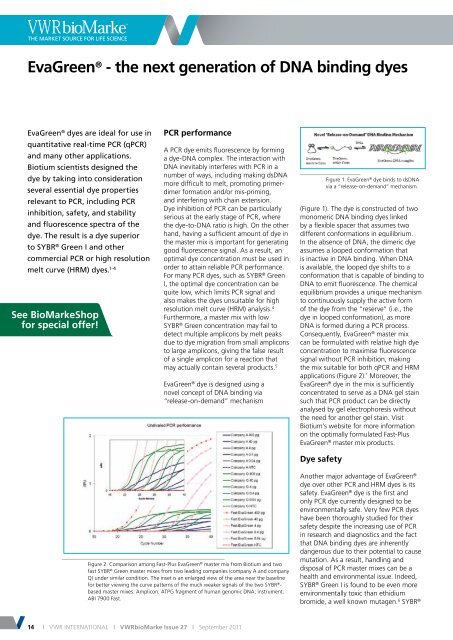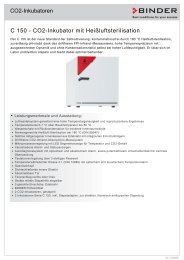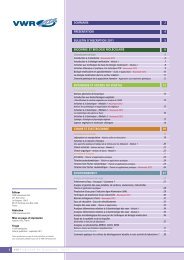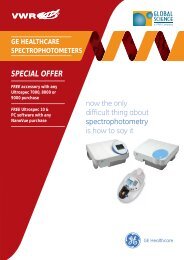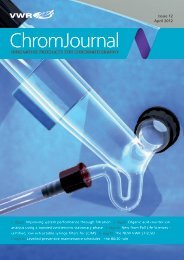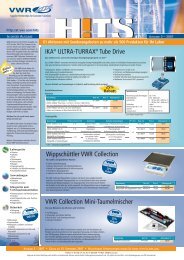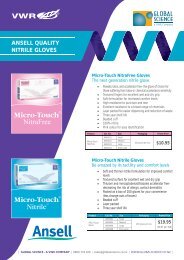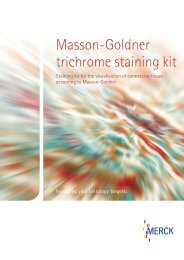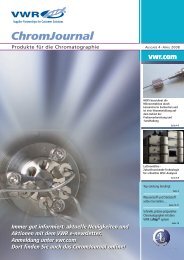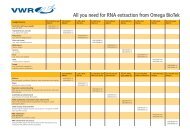CEll bIOlOGy
CEll bIOlOGy
CEll bIOlOGy
Create successful ePaper yourself
Turn your PDF publications into a flip-book with our unique Google optimized e-Paper software.
the market source for life science<br />
EvaGreen ® - the next generation of DNA binding dyes<br />
EvaGreen ® dyes are ideal for use in<br />
quantitative real-time PCR (qPCR)<br />
and many other applications.<br />
Biotium scientists designed the<br />
dye by taking into consideration<br />
several essential dye properties<br />
relevant to PCR, including PCR<br />
inhibition, safety, and stability<br />
and fluorescence spectra of the<br />
dye. The result is a dye superior<br />
to SYBR ® Green I and other<br />
commercial PCR or high resolution<br />
melt curve (HRM) dyes. 1-4<br />
See BioMarkeShop<br />
for special offer!<br />
PCR performance<br />
A PCR dye emits fluorescence by forming<br />
a dye-DNA complex. The interaction with<br />
DNA inevitably interferes with PCR in a<br />
number of ways, including making dsDNA<br />
more difficult to melt, promoting primerdimer<br />
formation and/or mis-priming,<br />
and interfering with chain extension.<br />
Dye inhibition of PCR can be particularly<br />
serious at the early stage of PCR, where<br />
the dye-to-DNA ratio is high. On the other<br />
hand, having a sufficient amount of dye in<br />
the master mix is important for generating<br />
good fluorescence signal. As a result, an<br />
optimal dye concentration must be used in<br />
order to attain reliable PCR performance.<br />
For many PCR dyes, such as SYBR ® Green<br />
I, the optimal dye concentration can be<br />
quite low, which limits PCR signal and<br />
also makes the dyes unsuitable for high<br />
resolution melt curve (HRM) analysis. 4<br />
Furthermore, a master mix with low<br />
SYBR ® Green concentration may fail to<br />
detect multiple amplicons by melt peaks<br />
due to dye migration from small amplicons<br />
to large amplicons, giving the false result<br />
of a single amplicon for a reaction that<br />
may actually contain several products. 5<br />
EvaGreen ® dye is designed using a<br />
novel concept of DNA binding via<br />
“release-on-demand” mechanism<br />
(Figure 1). The dye is constructed of two<br />
monomeric DNA binding dyes linked<br />
by a flexible spacer that assumes two<br />
different conformations in equilibrium.<br />
In the absence of DNA, the dimeric dye<br />
assumes a looped conformation that<br />
is inactive in DNA binding. When DNA<br />
is available, the looped dye shifts to a<br />
conformation that is capable of binding to<br />
DNA to emit fluorescence. The chemical<br />
equilibrium provides a unique mechanism<br />
to continuously supply the active form<br />
of the dye from the “reserve” (i.e., the<br />
dye in looped conformation), as more<br />
DNA is formed during a PCR process.<br />
Consequently, EvaGreen ® master mix<br />
can be formulated with relative high dye<br />
concentration to maximise fluorescence<br />
signal without PCR inhibition, making<br />
the mix suitable for both qPCR and HRM<br />
applications (Figure 2). * Moreover, the<br />
EvaGreen ® dye in the mix is sufficiently<br />
concentrated to serve as a DNA gel stain<br />
such that PCR product can be directly<br />
analysed by gel electrophoresis without<br />
the need for another gel stain. Visit<br />
Biotium’s website for more information<br />
on the optimally formulated Fast-Plus<br />
EvaGreen ® master mix products.<br />
Dye safety<br />
Figure 1. EvaGreen ® dye binds to dsDNA<br />
via a “release-on-demand” mechanism.<br />
Figure 2. Comparison among Fast-Plus EvaGreen ® master mix from Biotium and two<br />
fast SYBR ® Green master mixes from two leading companies (company A and company<br />
Q) under similar condition. The inset is an enlarged view of the area near the baseline<br />
for better viewing the curve patterns of the much weaker signals of the two SYBR ® -<br />
based master mixes. Amplicon: ATPG fragment of human genomic DNA; instrument:<br />
ABI 7900 Fast.<br />
Another major advantage of EvaGreen ®<br />
dye over other PCR and HRM dyes is its<br />
safety. EvaGreen ® dye is the first and<br />
only PCR dye currently designed to be<br />
environmentally safe. Very few PCR dyes<br />
have been thoroughly studied for their<br />
safety despite the increasing use of PCR<br />
in research and diagnostics and the fact<br />
that DNA binding dyes are inherently<br />
dangerous due to their potential to cause<br />
mutation. As a result, handling and<br />
disposal of PCR master mixes can be a<br />
health and environmental issue. Indeed,<br />
SYBR ® Green I is found to be even more<br />
environmentally toxic than ethidium<br />
bromide, a well known mutagen. 6 SYBR ®<br />
14<br />
I VWR International I VWRbioMarke Issue 27 I September 2011


